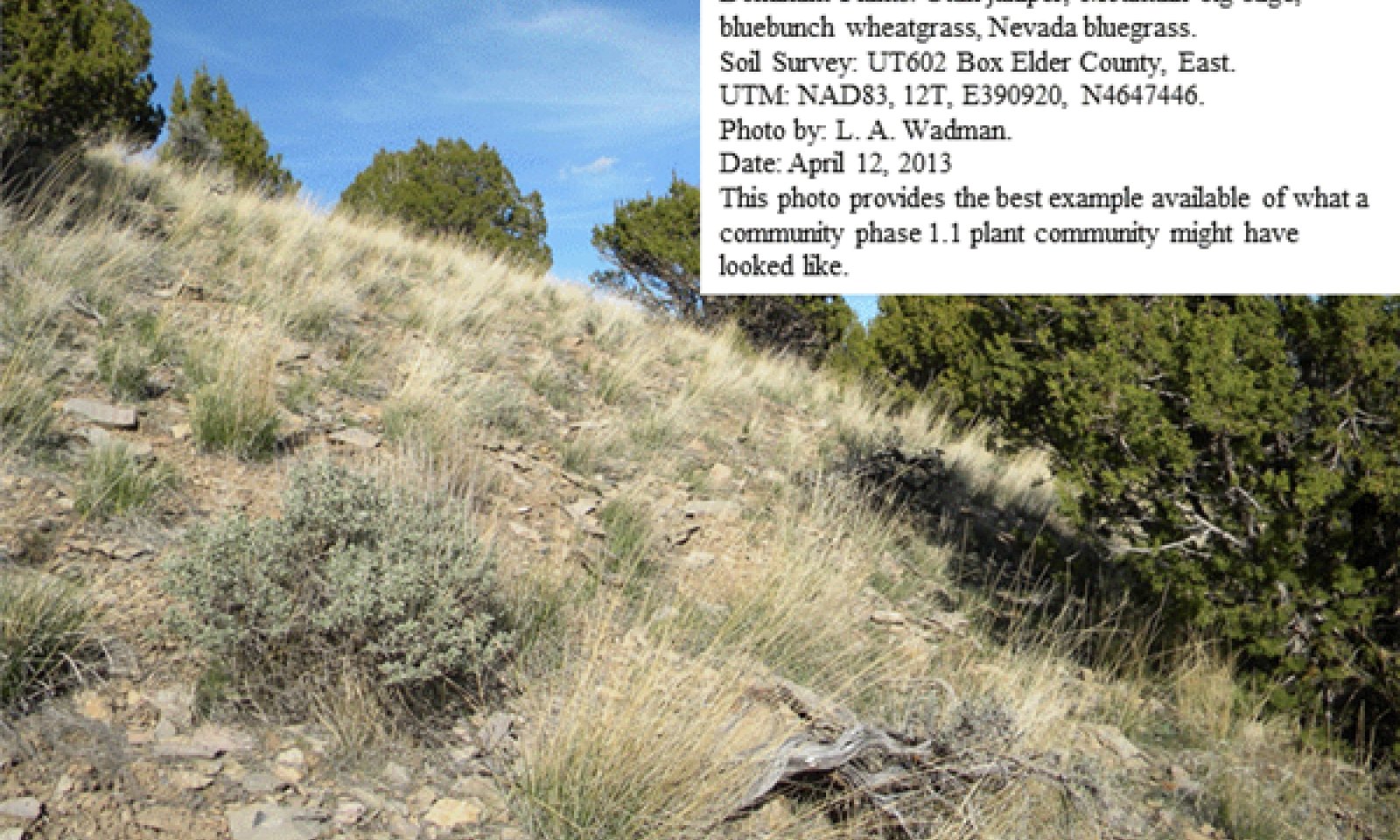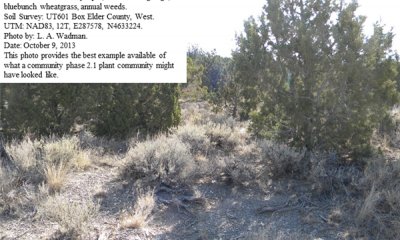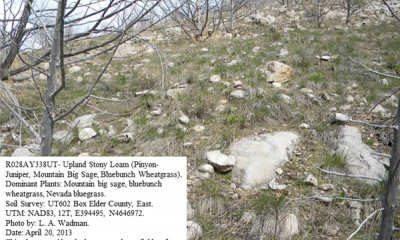
Upland Stony Loam (Pinyon-Utah Juniper)
Scenario model
Current ecosystem state
Select a state
Management practices/drivers
Select a transition or restoration pathway
- Transition T1A More details
- Transition T2A More details
- Restoration pathway R3A More details
-
No transition or restoration pathway between the selected states has been described
Target ecosystem state
Select a state
Description
The Reference State describes the various biotic communities that are expected to be found on this ecological site under natural conditions. The Reference State has an overstory canopy of singleleaf and/or two-needle pinyon, with lesser amounts of Utah juniper. The shrub layer is typically dominated by mountain big sagebrush. A mixture of other shrubs including black sagebrush, antelope bitterbrush, and Utah serviceberry are commonly found. Bluebunch wheatgrass is the dominant herbaceous species with Nevada bluegrass and Indian ricegrass commonly occurring. Other native grasses, forbs, and shrubs will often produce a significant portion of vegetative composition in the plant community.
The Reference State is self-sustaining and resistant to change due to a good natural resilience to its natural disturbances. The primary natural disturbance mechanisms are wildlife population densities which can affect the shrub layer composition, weather fluctuations, and fire period.
Reference State: Natural plant communities as influenced by tree and shrub canopy densities, long term weather fluctuations, and periodic fire.
Indicators: These communities are dominated by pinyon/juniper, mountain big sagebrush and bluebunch wheatgrass. The density of the tree and shrub canopies determines the amount and composition of the other native species present in the community.
Feedbacks: Natural fluctuations in weather patterns that allow for a self-sustaining tree, shrub and native grass community. Prolonged drought, an increase in fire frequency, or other disturbances may allow for the establishment of invasive species.
At-risk Community Phase: All communities are at risk when native plants are stressed and conditions are created that may allow invasive plants to establish.
Trigger: The establishment of invasive plant species.
Submodel
Description
The Current Potential State is similar to the Reference Sate except that non-native species are now present. This state describes the plant communities that may or have become established on this ecological site under various successional sequences and disturbance conditions. This state typically has a well developed overstory canopy composed of either two-needle or singleleaf pinyon with lesser amounts of Utah juniper. Mountain big sagebrush often dominates the shrub layer. Black sagebrush, antelope bitterbrush, and Utah serviceberry are common shrub species. Bluebunch wheatgrass is the dominant herbaceous species with Indian ricegrass, Nevada bluegrass, and other perennial grasses and forbs also commonly found in abundance. Cheatgrass, alyssum, various mustard species, and other non-native species are present on the site and, under certain circumstances, may visually dominate the sites aspect.
The primary disturbance mechanisms are the tree and shrub layer densities; the amount and kinds of invasive species present; weather fluctuations; and fire. The current potential state is still self-sustaining but may be losing its resistance to change due to the impact of disturbances with less resilience following those disturbances.
Current Potential State: Plant communities influenced by tree and shrub canopy density, long term weather fluctuations, and periodic fire. Invasive species are present in various amounts.
Indicators: A community dominated by pinyon/ juniper, mountain big sagebrush and bluebunch wheatgrass. The density of the tree and shrub canopies determines the amount and composition of the other native and introduced grasses and forbs that may be present.
Feedbacks: Natural fluctuations in weather patterns that allow for a self sustaining shrub and native grass community. Prolonged drought, more frequent fires, and/or other disturbances that may allow for the increase of invasive species.
At-risk Community Phase: All communities are at risk when native plants are stressed and nutrients become available for invasive plants to increase.
Trigger: A reduction of perennial grass and forb species combined with an increase of invasive plant species.
Submodel
Description
The Disturbance State describes the plant communities that may or have become established on this ecological site under various successional sequences and disturbance conditions. Two distinct community phases have been observed to date. The first describes the effects of recent crown fire, and the other describes communities where dense canopies of pinyon and juniper have been removed either by chaining, pushing, or chainsaw cutting. Non-native species are normally present in all community phases. Vegetative communities are quite variable depending the disturbance mechanism and pre-disturbance conditions. Fire will normally also remove mountain big sage and other fire sensitive species while mechanical removal usually leaves these species. Bluebunch wheatgrass, Indian ricegrass, Nevada bluegrass and other native perennial grass species are often abundant following fire but may also be reduced or missing following either disturbance. Western wheatgrass is usually still present on the site and along with invasive weedy species, including cheatgrass, alyssum, various mustard species and other non-native species, may visually dominate the sites herbaceous layer.
The primary disturbance mechanisms include recent crown fire or the mechanical removal of the overstory of pinyon/juniper; a shrub layer comprised of various amounts of mountain big sagebrush; significant amounts of invasive herbaceous species present; weather fluctuations, and pre-disturbance conditions. This state may be losing its resistance to change due to the impact of these disturbances and may have less resilience following those disturbances.
Disturbance State: Plant communities impacted by the removal of overstory of pinyon/juniper; a shrub canopy that may or may not contain mountain big sagebrush; long term weather fluctuations; and periodic fire.
Indicators: The density of the remaining tree and shrub canopies following disturbance determines the amount and composition of the other native and introduced grasses and forbs that may be present.
Feedbacks: Natural fluctuations in weather patterns following the removal of pinyon/juniper that may impact the remaining native shrub and grass communities. Prolonged drought, improper livestock grazing and/or other disturbances that allow for the increase of invasive species.
At-risk Community Phase: All communities are at risk when native plants are stressed and nutrients become available for invasive plants to increase.
Trigger: A reduction of perennial grass and forb species combined with an increase of invasive plant species.
Submodel
Mechanism
This transitional pathway occurs when any combination of improper livestock grazing, prolonged drought or other disturbance causes the perennial herbaceous community to become significantly reduced allowing non-native species such as cheatgrass, alyssum, Russian thistle and other invasive weeds to become established. Broom snakeweed may also increase during this time. Once invasive species occupy the site, a threshold has been crossed. Cheatgrass, however, has been known to become established in healthy communities on this site.
Mechanism
This transitional pathway occurs when a major fire or mechanical treatment removes nearly all the Utah juniper and any pinyon present from the site. A combination of improper livestock grazing, prolonged drought, or other disturbance can slow the expected recovery of the perennial herbaceous community, allowing non-native species such as cheatgrass, alyssum, Russian thistle, and other invasive weeds to flourish. Broom snakeweed may also increase during this time. Fire tolerant shrubs will often recover quickly during these periods.
Mechanism
This restoration pathway occurs when the site is well managed and fire is excluded for long periods of time. The natural fire cycle will be expected to occur but not for many years. The site will normally have a mix of native and introduced species including perennial grasses and annual and perennial grasses. Mountain big sagebrush will normally increase until it again dominates the shrub layer. Pinyon and Utah juniper will also return to normal, pre-disturbance levels during this time.
Model keys
Briefcase
Add ecological sites and Major Land Resource Areas to your briefcase by clicking on the briefcase (![]() ) icon wherever it occurs. Drag and drop items to reorder. Cookies are used to store briefcase items between browsing sessions. Because of this, the number of items that can be added to your briefcase is limited, and briefcase items added on one device and browser cannot be accessed from another device or browser. Users who do not wish to place cookies on their devices should not use the briefcase tool. Briefcase cookies serve no other purpose than described here and are deleted whenever browsing history is cleared.
) icon wherever it occurs. Drag and drop items to reorder. Cookies are used to store briefcase items between browsing sessions. Because of this, the number of items that can be added to your briefcase is limited, and briefcase items added on one device and browser cannot be accessed from another device or browser. Users who do not wish to place cookies on their devices should not use the briefcase tool. Briefcase cookies serve no other purpose than described here and are deleted whenever browsing history is cleared.
Ecological sites
Major Land Resource Areas
The Ecosystem Dynamics Interpretive Tool is an information system framework developed by the USDA-ARS Jornada Experimental Range, USDA Natural Resources Conservation Service, and New Mexico State University.










